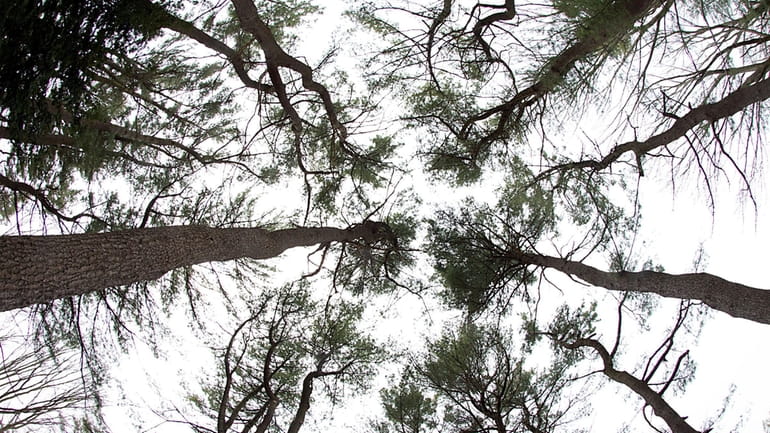Early allergies and warm winter bursts: What to know

Trees at the Clark Botanic Garden in Albertson. Credit: Newsday/J. Conrad Williams, Jr.
If you suffer from seasonal allergies, the last few weeks may have sent you scrambling for antihistamines earlier than usual. You aren’t alone.
The bursts of warm weather throughout the winter led some plants and trees to start budding even as snow flurries fell. Here is what you need to know about allergy season, pollen counts and how to find relief from the itching and sneezing.
Did allergy season start unusually early this year?
Experts believe so.
Typically in the winter season, there is a long period of freezing weather where most plant life goes dormant.
“That really didn’t happen this season,” said Dr. Punita Ponda, associate division chief of the Division of Allergy and Immunology at Northwell Health, leading to full blooms sooner than expected. “I would not be surprised if the allergy season is full-on very quickly.”
People with allergies who head outside on unusually warm winter days can be surprised by the high pollen counts. “If they didn’t start their premedication and then are thrown into this massively high pollen time period without preparation — the combination makes people feel miserable,” Ponda said.
Is allergy season lengthening?
In general, allergy season is getting longer due to earlier last spring frosts and later last fall frosts. The increased length of growing season has been most notable in the northeastern and western United States, said Dr. Andrew Rorie, assistant professor of allergy and immunology at the University of Nebraska Medical Center in Omaha.
“For a lot of different types of pollinating plants, we're seeing an increased production of pollen throughout the year.”
What is allergy season anyway?
In New York and other parts of the Northeast, allergy season tends to run from early spring through October. It starts with the pollen from trees in the spring, followed by grass in the spring and summer and then weeds, such as ragweed, from the end of August to the first frost, according to Dr. Catherine Monteleone, an allergist immunologist at Rutgers Robert Wood Johnson Medical School.
Flowers generally aren’t the issue, because they are pollinated by bees, she said.
“Trees, grass and weeds are wind pollinated,” Monteleone said. “Wind spreads pollen into the air and it lands on sticky surfaces, including the mucosa of your nose and your eyes. It’s all over your car, and it's flying in the air. It's not the leaf or the tree itself. It’s the pollen.”
People who have an immune response to pollen that enters their bodies create antibodies. When the pollen interacts with the antibodies, histamine is released from cells, which causes symptoms such as itchy eyes and a runny nose, she said.
How is pollen measured?
One of the most accurate ways to measure pollen is by gathering air samples and having them examined under a microscope, Rorie said.
The devices are placed on a rooftop and can collect samples for a 24-hour period or up to seven days.
“There are newer, automated devices that can identify and count the pollen that it sees in the air sample,” he said. “Those are a bit more real time in the data they produce, but they're not as accurate as the old-school looking under the microscope and counting.”
Counts are done by academic and government groups as well as private allergy practices. Rorie said the National Allergy Bureau is considered to have the most accurate data, culled from about 90 active sites handled by certified pollen counters.
How do I know if I have allergies or a cold?
People who have allergies might notice their symptoms repeat around the same time every year. “Usually colds can cause fever, aches and pains and you don't really get that with an allergy,” Monteleone said. “On the other hand, you don’t get itchy eyes or as sneezy with a cold. But some people get congestion and so when they first get an allergy, it's hard to tell.”
She said allergy symptoms also can include headaches, fatigue and wheezing.
What can I do to minimize allergy symptoms?
Following the daily pollen count is key, said Ponda, who tells her patients to limit outdoor activities between 6 and 10 a.m. on days when the counts are high.
“If you are going to go for a run, maybe go in the evening,” she said. Monteleone said keeping windows closed in cars and at home and running the air conditioner can help. She also suggests having “indoor” and “outdoor” clothes.
“Pollen’s sticky,” she said. “It's sticking to your hair, it's sticking to you, to your clothes. So come in, shower, change your clothes.”
Experts said people who believe they might have allergies might want to check with a specialist who can evaluate them and help determine which medication could stave off or minimize symptoms.

Updated now Newsday travel writer Scott Vogel took the ferry over to Block Island for a weekend of fun.

Updated now Newsday travel writer Scott Vogel took the ferry over to Block Island for a weekend of fun.

